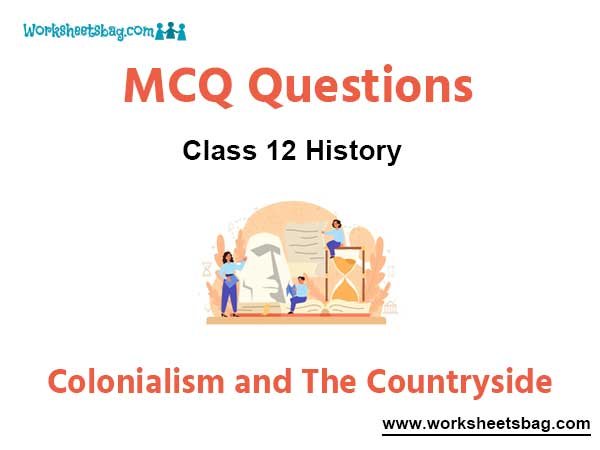Please refer to Colonialism and The Countryside MCQ Questions Class 12 History below. These MCQ questions for Class 12 History with answers have been designed as per the latest NCERT, CBSE books, and syllabus issued for the current academic year. These objective questions for Colonialism and The Countryside will help you to prepare for the exams and get more marks.
Colonialism and The Countryside MCQ Questions Class 12 History
Please see solved MCQ Questions for Colonialism and The Countryside in Class 12 History. All questions and answers have been prepared by expert faculty of standard 12 based on the latest examination guidelines.
MCQ Questions Class 12 Colonialism and The Countryside
Question. Who was the commander of the British forces during the American War of Independence?
OR
Name the Governor General of Bengal who introduced Permanent Settlement in 1793?
(a) John Simon
(b) Warren Hastings
(c) Lord Irwin
(d) Charles Cornwallis
Answer
D
Question. When was Fifth Report introduced in the British Parliament?
(A) 1770
(B) 1858
(C) 1813
(D) 1795
Answer
C
Question. Which of the statement(s) are correct about the duties of the Zamindars under permanent settlements
(1) Zamindars had several (sometimes as many as 400) villages under them.
(2) The Company fixed the total demand over the entire estate whose revenue the zamindar contracted to pay.
(3) The zamindar collected rent from the different villages, paid the revenue to the Company, and retained the difference as his income
(4) He was expected to pay the Company regularly, failing which his estate could be auctioned.
Which of the following statement(s) is/are correct?
(A) 1, 2, 4
(B) 1, 3, 4
(C) 3, 2, 4
(D) All of the above.
Answer
D
Question. In Permanent Settlement, sometimes zamindars failed to pay the revenue demand and unpaid balances accumulated. Which of the statement(s) are correct regarding
zamindars failed to pay the revenue demand?
(1) The initial demands were very high. The Company pegged the revenue demand high, arguing that the burden on zamindars would gradually decl ine as agricultural production
expanded and prices rose.
(2) High demand was imposed in the 1790s when the prices of agricultural produce were contented.
(3) The zamindar collected rent from the different villages, paid the revenue to the Company, and retained the difference as his income.
(4) He was expected to pay the Company regularly, failing which his estate could be auctioned.
Which of the following statement(s) is/are correct?
(A) 1, 2, 4
(B) 1, 3, 4
(C) 3, 2, 4
(D) All of the above.
Answer
A
ASSERTION AND REASON BASED MCQs :
Question. Assertion (A): The East India Company realised that there was a need to fix the revenue amount for regular flow of income.
Reason (R): British officials felt that agriculture, trade and the revenue resources of the state could all be developed by encouraging investment in agriculture.
(A) Both A and R are true and R is the correct explanation of A.
(B) Both A and R are true but R is NOT the correct explanation of A.
(C) A is true but R is false.
(D) A is false and R is true.
Answer
A
Question. Assertion (A): In the early decades after the Permanent Settlement, zamindars regularly failed to pay the revenue demand and unpaid balances accumulated.
Reason (R): The Company had recognised the zamindars as important, but it wanted to control and regulate them, subdue their authority and restrict their autonomy.
(A) Both A and R are true and R is the correct explanation of A.
(B) Both A and R are true but R is NOT the correct explanation of A.
(C) A is true but R is false.
(D) A is false and R is true.
Answer
B
Question. Assertion (A) : The Paharias regularly raided the plains where settled agriculturists lived.
Reason (R) : In the 1770s the British embarked on a brutal policy of extermination, hunting the Paharias down and killing them.
(A) Both A and R are true and R is the correct explanation of A.
(B) Both A and R are true but R is NOT the correct explanation of A.
(C) A is true but R is false.
(D) A is false and R is true.
Answer
B
Question. Assertion (A) : The British turned to the Santhals and they were given land and persuaded to settle in the foothills of Rajmahal.
Reason (R) : Having failed to subdue the Paharis and transform them into settled agriculturists, the British turned to the Santhals.
(A) Both A and R are true and R is the correct explanation of A.
(B) Both A and R are true but R is NOT the correct explanation of A.
(C) A is true but R is false.
(D) A is false and R is true.
Answer
A
CASE-BASED MCQs :
Question. Study this extract of the Fifth report and answer the following questions:
Referring to the condition of Zamindars and land, the Fifth Report stated: The revenue was not realized with punctuality, and lands to a considerable extent were periodically exposed to sale by auction. In the native year 1203, corresponding with 1796-97, the land advertised for sale comprehended a Jumma or assessment of Sicca Rupees 28,70,061, the extent of land actually sold bore a Jumma or assessment of 14,18,756, and the amount of purchase money Sicca Rupees 17,90,416. In 1204, corresponding with 1797-98, the land advertised was for Sicca Rupees 26,66,191, the quantity sold was for Sicca Rupees 22,74,076, and the purchase money Sicca Rupees 21,47,580. Among the defaulters were some of the oldest families of
the country. Such were the Rajahs of Nuddea, Rajeshaye, Bishenpore (all districts of Bengal), and others, the dismemberment of whose estates at the end of each succeeding year, threatened them with poverty and ruin, and ruin, and in some instances presented difficulties to the revenue officers, in their efforts to preserve undiminished the amount of public assessment.
Question. Assertion (A): Among the defaulters were some of the oldest families of the country.
Reason (R): The revenue was not realized with punctuality, and lands to a considerable extent were periodically exposed to sale by auction.
(A) Both A and R are correct and R is the correct explanation of A.
(B) Both A and R are correct but R is not the correct explanation of A.
(C) A is correct but R is wrong.
(D) R is correct but A is wrong.
Answer
B
Question. What are the officials who wrote the Fifth Report trying to show through these figures?
(A) Maladministration, corruption and misrule by the East India Company Officials.
(B) Drawback of the system of permanent settlement.
(C) Inefficiency in revenue collection.
(D) Only (B) and (C)
Answer
A
Question. Long term generalisations from these figures of two years may lead to misinterpretation of the actual situation. How?
(A) As these were the years when Zamindars faced problems.
(B) There could be exaggeration of facts.
(C) Both (i) and (ii).
(D) None of the above.
Answer
C
Question. What do you think, according to this extract is the meaning of Jumma?
(A) The amount collected as land revenue.
(B) The amount collected from the auction of the land.
(C) The officials assessment of land revenue.
(D) All of the above.
Answer
C



